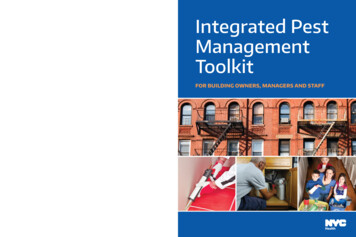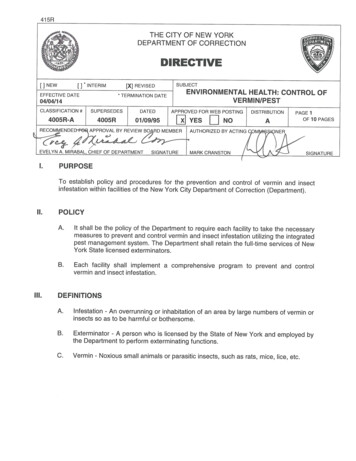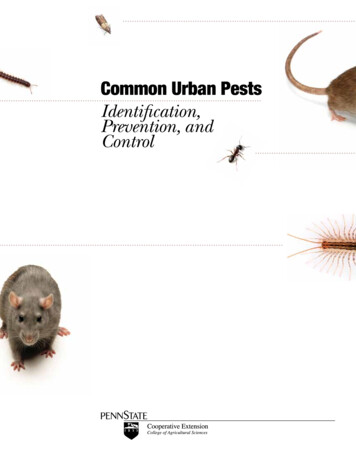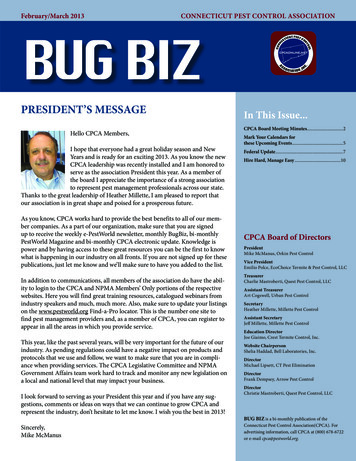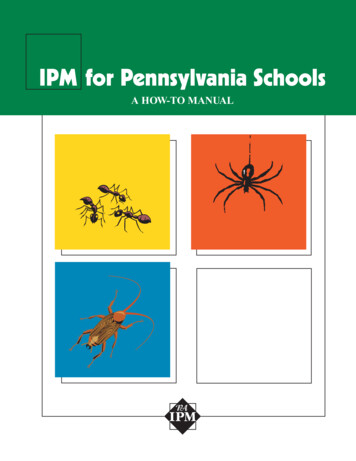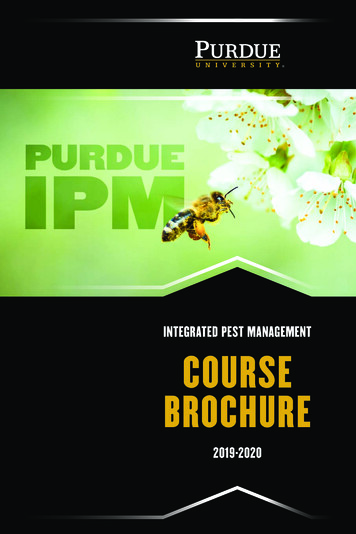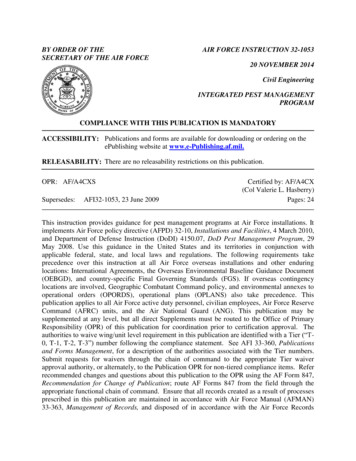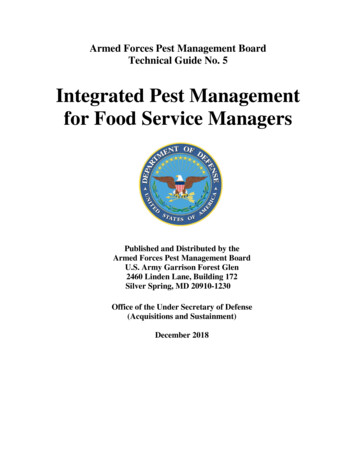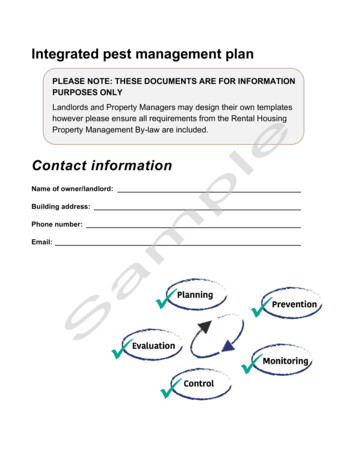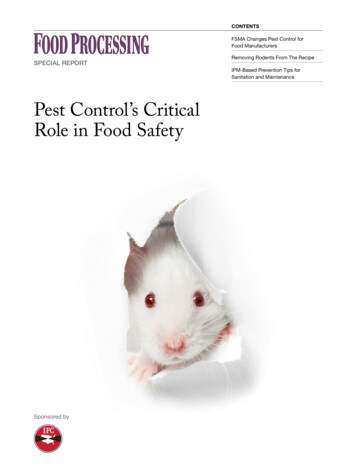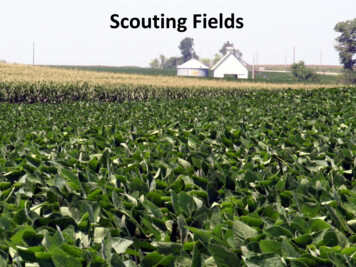
Transcription
Scouting Fields
Overview1. Do your homework2. Basics of scouting3. Help! I still don’t know
Know what “healthy” looks like What does a normal plant look like?– Above ground– Below ground– On the inside A sick plant is less productive and often givesindicators (e.g., color or growth) called“symptoms.” If you know what a healthy plant looks like,you can recognize when there is a problem.
Know common problems
Know common problems
Know common problemsAssemble references Books Publications Etc.
Know common problems THIS year Keep up on the news––––Local agribusinessInternetPrint mediaWord of mouth
Know common problems foreach time of yearTimeline for common corn diseasesCorn growth stage:SeedlingblightsVTV6Anthracnoseleaf blightV12EyespotR2GLS; Common rust;Northern corn leaf blightCommonrustVTGray leafspot (GLS)R4R6Anthracnosetop diebackStalk rots;Ear rots
Basics of scouting Accurately estimate crop plant health,stand, growth stage and populationsof any pests present Pest identification and/or diagnosis ofthe cause of crop injury
First steps of scouting Gather equipment Contact grower Let them know when you are coming Ask if there are any special instructions Spend time with them Collect information about thefield/season – learn the field history
Equipment needs Field maps Field guides Paper and pen to takenotes Safety glasses Hand lens Pocket knife/scissors Sampling bags/envelopes Old newspapers/paper towels Sharpies Ice chest First aid kit Water Digital camera
Collect informationMap fields Aerial photographs Map from plat book or Google Maps
Collect informationMap fields Soil map (printed soil survey or download)http://websoilsurvey.nrcs.usda.gov/app/
Collect informationConsider recent weather Environmental stresses may damage soybeanand corn directly or make them moresusceptible to some diseases.
Collect informationCollect background information for the field Previous crops, adjacent crop and non-crop areas Chemicals used on or near the crop includingherbicides, fertilizers, fungicides and insecticides;indicate when applied, how applied, rate ofapplication, weather conditions during andfollowing application Planting date, depth, and seedbed conditions Hybrid/variety information, including diseaseresistance Current soil test information (e.g., soil fertility, pH) Soil moisture and compaction
Collect informationQuestions for the end of the season How are plants standing? What does the ear/pods look like? What is stalk strength and health of rootsystem? Yield, why good or bad? How was weed control?
Basics of scouting1. Look at the BIG picture (field level)2. Look at the little picture (plant level)3. Record information
1. Look at the BIG picture (field)i. Is the problem scattered randomly through thefield or occurring in a pattern?ii. Is the problem more prevalent along a fence, fieldedge, entrance of a field or along a waterway?iii. Is the problem in the affected area more severe incertain soil types, low areas or on exposed slopes?iv. Does the pattern correspond to tillage, planting,spraying, harvesting or other field activities?LOOK FOR PATTERNS
Look for patternsRandomAggregatedT. Allen, Miss. St.
Look for patternsAggregatedAggregated Marlin E. RiceSlope
Look for patternsRepeatedEquipment can oftencause patterns that arerepeated across fields.For example, sprayoverlap every time thebooms overlapped,compacted areas every"x" rows from combinetires the prior fall, etc.
Scouting patternsTransectZig-zagDiamond
2. Look at the little picture (plant)Check individual plants for symptoms and signsi. Compare damaged plants with healthy plants.ii. Check the entire plant and environment around it,including leaves, stems, roots, internal tissues, soil,pests not directly on plant, competition, etc.iii. A small hand lens, a pocket knife, a trowel, a shoveland the field guides are valuable tools.
Check individual plants
Look at more than one plant1010151010101015101015101015Aim to assess a minimum of 50-100 plants
Scouting patterns Sampling patterns should be modified toaccount for variation in a field. Random problem (e.g., some insects)– Fewer stops– More plants assessed at each stop Aggregated (e.g., soilborne disease)– More stops (some in and out of problem areas)– Fewer plants assessed at each stop
If possible, identify problem After scouting field, identifying patterns,identifying plants that do not appearnormal, etc. – use all the availableinformation to identify the problem(s).
3. Record informationi. Check the prevalence and severity of the problem. How often does the problem show up? How damaging is the problem?
Assessment methods Incidence % plants diseased Severity % tissue diseased
Foliar disease severity (%)Gray leaf spot1%2%5%10 %Corn.Pro, Nutter, ISU
Stalk disease severity valueR. Hines, UIL
Recording information Field notebook Clipboard with spreadsheetDamage severity (%)FieldStop111213141516171812345678910
Stumped?If you are unsure of the problem or want asecond opinion, you can send samples to PlantDiagnostic Clinics.
Information on submitting samplesPage 11Page 21
ISU Plant and Insect Diagnostic ClinicIf unsure of the cause of the problem, symptomaticspecimens can be sent to the ISU Plant and InsectDiagnostic Clinic.ISU Plant and Insect Diagnostic ClinicIowa State University327 Bessey HallAmes, IA dc/Ph: 515-294-0581
Submitting plants Provide plenty of fresh material. When possible,send the entire plant, including roots.
Submitting plants Include enough plant material to show a range ofsymptoms.
Submitting plants Provide appropriate background information for thefield.
Submitting plants Wrap specimens in dry papertowels or clean newspaper(do not add moisture), thensecurely wrap sample.
Submitting plants Other tips‒ Do not send in dead tissue (the sample below is aproblem).‒ Include photos when possible.
What next Diagnosing a problem and properly recording thisinformation can help with the next steps. Management decisions, either for this year orsubsequent years, can be implemented. Proper identification can help pick the correctmanagement strategy. Realizing what can happen if the problem is notaddressed.
Summary Do your homework. Scout the field. Can’t diagnose the problem? – Ask for help!
First steps of scouting Field maps Field guides Paper and pen to take notes Safety glasses Hand lens Pocket knife/scissors Sampling bags/ envelopes Equipment needs Old newspapers/ paper towels Sharpies Ice chest First aid kit Water D
